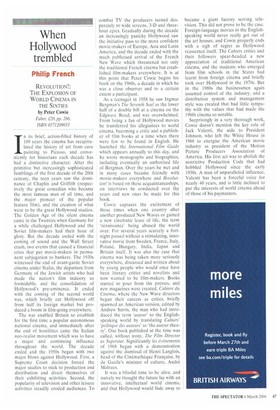When Hollywood trembled
Philip French
REVOLUTION!: THE EXPLOSION OF WORLD CINEMA IN THE SIXTIES by Peter Cowie Faber, £20, pp. 286, ISBN 0571209033 In its brief, action-filled history of 109 years the cinema has recapitulated the history of art from cave painting to Picasso, and conveniently for historians each decade has had a distinctive character. After the primitive but increasingly sophisticated fumblings of the first decade of the 20th century, the teen years saw the dominance of Chaplin and Griffith (respectively the great comedian who became the most famous man of all time, and the major pioneer of the popular feature film), and the creation of what were to be the great Hollywood studios. The Golden Age of the silent cinema came in the Twenties when Germany for a while challenged Hollywood and the Soviet film-makers had their hour of glory. But the decade ended with the coming of sound and the Wall Street crash, two events that caused a financial crisis that put movie-makers in permanent subjugation to bankers. The 1930s witnessed the end of avant-garde Soviet cinema under Stalin, the departure from Germany of the Jewish artists who had made the nation's film industry so formidable, and the consolidation of Hollywood's pre-eminence. It ended with the coming of the second world war, which briefly cut Hollywood off from half its foreign market but produced a boom in film-going everywhere.
The war enabled Britain to establish for the first time a popular autonomous national cinema, and immediately after the end of hostilities came the Italian neo-realist movement which was to have a major and continuing influence throughout the world. The decade ended and the 1950s began with two major blows against Hollywood. First, a Supreme Court decision forced the major studios to stick to production and distribution and divest themselves of their exhibiting activities. Second, the popularity of television and other leisure activities steadily eroded audiences. To combat TV the producers turned desperately to wide screens, 3-D and threehour epics. Gradually during the decade an increasingly panicky Hollywood saw the initiative pass to the more confident movie-makers of Europe, Asia and Latin America, and the decade ended with the much publicised arrival of the French New Wave which threatened not only the traditional French cinema but established film-makers everywhere. It is at this point that Peter Cowie begins his book on the 1960s, a decade in which he was a close observer and to a certain extent a participant.
As a teenager in 1958 he saw Ingmar Bergman's The Seventh Seal as the lower half of a double bill at a cinema on the Edgware Road, and was overwhelmed. From being a fan of Hollywood movies he transferred his allegiances to world cinema, becoming a critic and a publisher of film books at a time when there were few to be found in English. He launched the International Film Guide which appears annually to this day, and he wrote monographs and biographies, including eventually an authorised life of Bergman. Over the years he met and in many cases became friendly with movie-makers everywhere and Revolution! is based on these acquaintanceships, on interviews he conducted over the years and new ones he made for this book.
Cowie captures the excitement of those times when one country after another produced New Waves or gained a new cinematic lease of life, the term 'renaissance' being abused the world over, For several years scarcely a fortnight passed without a stimulating, innovative movie from Sweden, France, Italy, Poland, Hungary, India, Japan and Britain itself. It was also the case that cinema was being taken more seriously everywhere, discussed and written about by young people who would once have been literary critics and novelists and now wanted to be film-makers. Books started to pour from the presses, and new magazines were created. Cahiers du Cinema, where the New Wave directors began their careers as critics, briefly spawned an American version, edited by Andrew Sarris, the man who had introduced the term `auteur' to the Englishspeaking world by translating Cahiers' Politique des auteurs' as 'the auteur theory'. One book published at the time was called, without irony, The Film Director as Superstar. Significantly les evenements of 1968 began with a demonstration against the dismissal of Henri Langlois, head of the Cinematheque Francaise, by de Gaulle's minister of culture, Andre Malraux,
It was a blissful time to be alive, and naively we thought the future lay with an innovative, intellectual world cinema, and that Hollywood would fade away to
became a giant factory serving television. This did not prove to be the case. Foreign-language movies in the Englishspeaking world never really got out of the art houses, and Cowie properly ends with a sigh of regret as Hollywood reasserted itself. The Cahiers critics and their followers spear-headed a new appreciation of traditional American cinema, and the students who emerged from film schools in the States had learnt from foreign cinema and briefly took over Hollywood in the 1970s. But in the 1980s the businessmen again assumed control of the industry, and a distribution system and management style was created that had little sympathy with the values that had made the 1960s cinema so notable.
Surprisingly in a very thorough work, Cowie doesn't mention the key role of Jack Valenti, the aide to President Johnson, who left the White House in 1966 to energise the American movie industry as president of the Motion Picture Producers Association of America. His first act was to abolish the restrictive Production Code that had hobbled Hollywood since the early 1930s. A man of unparalleled influence, Valenti has been a forceful voice for nearly 40 years, and is little inclined to put the interests of world cinema ahead of those of his paymasters.


















































































 Previous page
Previous page